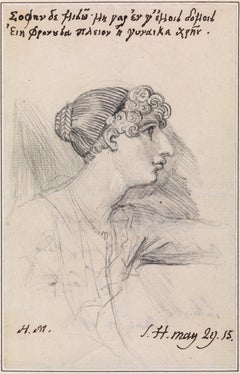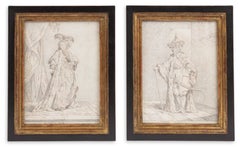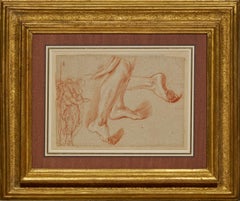Henry Fuseli Drawings and Watercolor Paintings
to
2
2
2
1
1
Overall Height
to
Overall Width
to
2
2
2
2
1
1
1
1
1
2
806
412
269
228
1
1
Artist: Henry Fuseli
Drawing of a captive woman
By Henry Fuseli
Located in London, GB
Collections:
Sir Thomas Lawrence, who acquired the contents of Fuseli’s studio;
Susan, Countess of Guilford, née Coutts (1771-1837), acquired from the Lawrence estate;
Susan, Baroness North (1797-1884), daughter of the above;
Mrs A. M. Jaffé, acquired in France, c. 1950 to 2016.
Black chalks, on buff-coloured paper
Stamped verso: ‘Baroness Norths Collection / of Drawings by H Fuseli Esq.’
Framed dimensions: 26.38 x 20.63 inches
This boldly drawn sheet depicting a seated figure was made by Fuseli at an important and highly productive moment in his career. The monumental drawing is closely related to another sheet by Fuseli in the British Museum which Schiff published as subject unknown. Both drawings were made when Fuseli was designing his most important sequence of historical works, including scenes from Shakespeare and Milton, The Nightmare and The Death of Dido which was exhibited at the Royal Academy to great critical acclaim in 1781. The present drawing does not relate directly to any of Fuseli’s finished historical paintings of the period, but evidently the image of a slightly menacing, seated and covered old woman was precisely the sort of motif he was playing with. It is notable that the same figure reappears later in Fuseli’s work as the witch from Ben Jonson’s Witch’s Song which Fuseli produced as both a painting and engraving in 1812.
Fuseli returned to London in 1779 from a highly creative and productive period in Rome and established himself as one of the leading history painters of the period. Fuseli re-established contact with his old mentor Sir Joshua Reynolds, becoming a regular guest at his dinner table and visitor to his studio. The earliest and most striking manifestation of this strategy was Fuseli's Death of Dido, exhibited in 1781 at the Royal Academy. Executed on the same scale as Reynolds's version (Royal Collection), Fuseli's vertically oriented picture was hung directly opposite Reynolds's with its horizontal orientation, inevitably inviting comparison between the two works and garnering Fuseli much publicity and favourable reviews in the newspapers.
The present, previously unpublished sheet, relates closely to a drawing now in the British Museum. That sheet shows the same seated old woman, drawn on a smaller scale and more schematic in design, seated next to an anatomical drawing of a man. The pose of this figure is related to the pose of Dido in his Death of Dido; the foreshortened torso, arrangement of head, oblique view of Dido’s features and arms all suggest that the study can be viewed as an initial thought for the composition. Fuseli may have initially thought of including the figure of the hunched and covered old woman. Drawn on identical paper to the British Museum sheet, our study is an enlarged depiction of the same figure, more elaborately delineated and developed. The presence of a chain to the right of the figure, suggests that the iconography was related in some way to a scene of imprisonment.
Fuseli had first explored the motif of the hooded old woman in an early Roman drawing, 'The Venus Seller'. The idea of a grotesque old woman, hooded and with angular nose and projecting chin seen in profile was most spectacularly used by Fuseli in his sequence of paintings depicting The Three Witches from Macbeth. Fuseli seems to have kept the present sheet and may have returned to it when preparing a painting of The Witch and the Mandrake from Ben Jonson’s Witch’s Song from his Masque of Queens in 1812. Here the same seated figure looks out from under her hood and picks a mandrake by moonlight. Jonson’s drama had been performed at the court of James I in 1609, inspired the subject. To throw the nobility of the queens into relief, the poet added a coven of witches, one of whom declares: ‘I last night lay all alone, On the ground, to hear the mandrake groan; And plucked him up, though he grew full low, And, as I had done, the cock did crow.’ The figure was reversed in the associated etching which was published in 1812. It seems likely that the present drawing remained as part of Fuseli’s working archive of figure studies.
The present drawing was presumably purchased with the bulk of Fuseli’s drawings after the artist’s death by Sir Thomas Lawrence. Lawrence’s large group of Fuseli drawings were then acquired by Susan, Countess of Guildford (1771-1837). Lady Guildford was the eldest daughter of the banker Thomas Coutts (1735-1822), who himself had supported Fuseli’s journey to Rome in the 1770s and had remained one of the artist’s key...
Category
18th Century Old Masters Henry Fuseli Drawings and Watercolor Paintings
Materials
Chalk
Portrait drawing of Harriot Mellon, Mrs Thomas Coutts
By Henry Fuseli
Located in London, GB
Inscribed by the artist in pen and brown ink, upper margin: 'σοφὴν δὲ μισῶ: μὴ γὰρ ἔν γ' ἐμοῖς δόμοις / εἴη φρονοῦσα πλείον' ἢ γυναῖκα χρή [Euripides, Hippolytus, 11, 640-41: “But a ...
Category
19th Century Old Masters Henry Fuseli Drawings and Watercolor Paintings
Materials
Pencil
Related Items
Costume drawings for ‘Ambassadeur de Siam’ and ‘La Sultana Reine’
Located in Amsterdam, NL
Joseph-Marie Vien (1716-1809)
‘Ambassadeur de Siam’ and ‘La Sultana Reine’
Both titled lower centre, the drawing of the ambassador inscribed with colours intended for the prints, e...
Category
Mid-18th Century Old Masters Henry Fuseli Drawings and Watercolor Paintings
Materials
Pencil, Paper
Free Shipping
H 9.26 in W 6.89 in D 1.19 in
A red chalk study sheet by Baldassare Franceschini, known as Volterrano
Located in PARIS, FR
This fresh sanguine sheet presents various studies placed next to each other in no apparent order. Two of the feet studies are preparatory to the first major commission received by the young Baldassare Franceschini, shortly after his installation in Florence, the frescoes for the Medici Fastes. This cycle was executed between 1636 and 1646 for the Villa La Petraia, a Medici villa on the outskirts of Florence, which allows us to date this sheet to the artist's youth.
1. The Medici Fastes, the first major commission for a young artist
Born in Volterra in 1611, the town from which he took his nickname, Baldassare Franceschini apprenticed with his father, a sculptor of alabaster, one of his home town's specialities, and studied with Cosimo Daddi (1540-1630), a local artist. The Marquis Inghirami, who spotted his talent, sent him to the workshop of Matteo Rosselli (1578 - 1650) in Florence, which was also attended by Francesco Furini (1603 - 1646).
In 1636, Lorenzo de' Medici, the youngest son of Ferdinand Ier and Christine of Lorraine, chose the 25-year-old artist, again on the advice of the Marquis Inghirami, to decorate with frescoes the loggias of the inner courtyard of the Villa La Petraia, which he had just inherited on the death of his mother. The project lasted about ten years and included ten scenes placed symmetrically in two loggias on either side of the courtyard: four main scenes and six placed above the doors, each to the glory of a member of the Medici family.
This decoration was his major secular project, but Volterrano also executed several religious frescoes and a few easel paintings, often with less success. Among the religious commissions, we can cite the dome of the Colloredo chapel dedicated to Saint Lucy...
Category
Mid-17th Century Old Masters Henry Fuseli Drawings and Watercolor Paintings
Materials
Paper, Chalk
Memento mori - A study of a Skull
Located in Stoke, Hampshire
E. Rusch (late 19th century)
Memento mori - Study of a skull
Pencil drawing
Drawing Size - 11 x 18 in
Framed Size - 17 1/2 x 24 1/2 in
Memento mori is an artistic or symbolic trope acting as a reminder of the inevitability of death. The concept has its roots in the philosophers of classical antiquity and Christianity, and appeared in funerary art and architecture from the medieval period...
Category
19th Century Old Masters Henry Fuseli Drawings and Watercolor Paintings
Materials
Pencil
Ancient Persian Miniature - Original China Ink and Watercolour - 19th Century
Located in Roma, IT
Ancient Persian Miniature is an original China Ink and Watercolour realized by an artist of 19th Century.
Good condition for a little brown ...
Category
19th Century Old Masters Henry Fuseli Drawings and Watercolor Paintings
Materials
Watercolor, Ink
H 7.88 in W 4.73 in D 0.04 in
Carretto Siciliano (Sicilian Carriage) - Watercolor by M. De Vito - 1820 ca.
By Michela De Vito
Located in Roma, IT
Watercolour on ivory colored and watermarked paper"J. Whatm Turkey M.", 1820 c.a.
Beautiful watercolour representing a typical Italian scene of ordinary life in XIX century: people...
Category
1820s Old Masters Henry Fuseli Drawings and Watercolor Paintings
Materials
Watercolor
H 10.24 in W 12.41 in D 0.04 in
Fine 18th Century Italian Old Master Drawing Mother & Children
Located in Cirencester, Gloucestershire
Giovanni Battista Cipriani, RA,
Italian 1727-1785
Sketch of a mother with three children;
black and red chalk on laid paper with watermark '© TAYLOR', 22.4 x 17.5 cm.
Provenanc...
Category
18th Century Old Masters Henry Fuseli Drawings and Watercolor Paintings
Materials
Chalk
French School, Academic Study (Male Nude)
Located in London, GB
Pencil on paper, dated (lower right), 55cm x 44cm (76cm x 64cm framed)
Drawings and paintings of the nude were central to academic art training in Europe from the 16th century onwar...
Category
1850s Old Masters Henry Fuseli Drawings and Watercolor Paintings
Materials
Paper, Carbon Pencil
Study of a Sleeping Girl in a Cap
By Jean-Baptiste Greuze
Located in Middletown, NY
Graphite on greenish gray wove paper. 15 1/4 x 11 5/8 inches (390 x 295 mm). Initialed "G. B." in pencil on the lower right recto. In generally good condition with some minor scattered surface soiling. Condition is consistent with age.
____
This drawing is closely related to two known mid 18th century oils...
Category
18th Century Old Masters Henry Fuseli Drawings and Watercolor Paintings
Materials
Handmade Paper, Graphite
English School early 19th century, Portrait of two children, drawing
Located in Paris, FR
English School early 19th century,
Portrait of two children,
Pencil and light heightenings of white and red gouache
29.5 x 23 cm
In quite good condition : the pape is yellowed by time and there foxings and stains visible (please refer to the photographs)
In a vintage frame (some minor damages) : 48.5 x 38 cm
This charming drawing of children is typical of English portraiture as it had its heyday shortly before with Reynolds and Gainsborough. The codes required, for example, that the female sitter...
Category
Early 1800s Old Masters Henry Fuseli Drawings and Watercolor Paintings
Materials
Pencil
H 11.62 in W 9.06 in
A dazzling Venetian Regatta Boat Study attributed to Alessandra Mauro
Located in PARIS, FR
This stunning Baroque study depicts a regatta boat, a type of vessel developed in eighteenth-century Venice for the regattas organized by the Serenissima during visits by royalty and princes. We propose to link this drawing to the work of Alessandro Mauro, an artist who specialized in this type of composition, as illustrated by a drawing from him at the Metropolitan Museum.
1. Description of the boat
The greatest decorative fantasy reigns in this preparatory study, which blends mythological and exotic elements with references to ancient Egypt. Our drawing is probably an initial thought, destined to be refined and clarified later in pen and ink (as evidenced by the ink stain in the lower right). A quadriga of seahorses guided by Neptune stands at the stern of the boat, shown well above the waterline (perhaps to outline its empty volume). One of the seahorses is ridden by a newt, while Amphitrite lies at the feet of the sea god.
The center of the boat is occupied by a vast baldachin resting on four atlantes and surmounted by a figure riding an animal (a dragon?). Three figures sit beneath the canopy, one of them on a griffin-shaped seat. This allusion to Egyptian antiquity echoes the winged sun (sometimes a symbol of the god Horus, as in the temple of Edfu in Egypt) that adorns the sides of the promontory on which this baldachin rests.
Another flag-bearer figure crouches at the stern of the boat on a raised seat, on the reverse of which is a crowned mermaid whose arm, extended backwards, rests on a mascaron decorated with a radiant face (Helios?) and whose torso surmounts an elephant's head. The heads of the rowers and their oars are sketched all along the boat, whose sides are embellished with elongated naiads.
2. The Venetian regatta boats
An exhibition held in 2013 at the Ca' Rezzonico (the Venetian eighteenth-century museum) paid tribute to these regatta boats through studies and prints depicting them. The regattas organized by the Serenissima in honor of visiting princes and sovereigns were among the most spectacular ceremonies in Venice. Some important artists of the 18th century contributed to the creation of these extravagant boats which were given exotic names such as bissona, malgarota or peota.
The specialists in this field were Andrea Urbani and the brothers Alessandro and Romualdo Mauro. They were born into a family of theater decorators in Piedmont, but little is known about their detailed biography. Alessandro was the architect of the Dresden opera house and of the St. Samuel Theater in Venice (in collaboration with his brother Romualdo), but also worked as stagehand and set designer in Vienna, Rome and Turin. A drawing produced around 1737 from the Metropolitan Museum (7th photo in the gallery) bears witness to his activity as a regatta boat designer.
This drawing is a much more elaborate version than the one presented here, having been entirely reworked in brown ink. However, a figure at the bow of the boat, executed solely in black chalk, still bears witness to a technique similar to that of our drawing.
It is difficult to know whether the boat depicted in our drawing was a project for an actual boat or whether it remained in the planning stage, but the front of our boat (Neptune and the quadriga of seahorses ridden by a newt) bears several similarities to that of a parade boat depicted in the print published by Michele Marieschi entitled Regatta on the Grand Canal, between the Foscari and Balbi Palaces (last photo in the gallery). This print is dated 1741, which could confirm that our work dates from around 1740.
The area between Neptune and the quadriga that precedes him on this strange paddle-boat appears to be partially submerged, confirming that the waterline of our boat was probably intended to be much lower than the one shown in our drawing.
The Correr Museum’s collection holds one of the most important collection of engravings and drawings devoted to these specifically Venetian Baroque productions. These boats were intended to last the duration of a festival. Today, they are only documented by preparatory drawings or prints that testify to the sumptuousness of their decoration. This taste for regatta boats lasted throughout the Venetian eighteenth century, and the conception of regatta boats also attracted great masters such as Giambattista Tiepolo, Francesco Guardi or Giambattista Piranesi...
Category
Mid-18th Century Old Masters Henry Fuseli Drawings and Watercolor Paintings
Materials
Chalk
H 15.75 in W 19.25 in
Portrait of a Lady, Drawing Signed and Dated by Augustin de Saint-Aubin
By Augustin de Saint-Aubin
Located in PARIS, FR
This drawing full of freshness presents us with the profile of an elegant lady, drawn by Augustin de Saint-Aubin on a beautiful summer day in 1776, during the early months of Louis X...
Category
1770s Old Masters Henry Fuseli Drawings and Watercolor Paintings
Materials
Pastel, Pencil
The Assumption of Mary Magdalene, Italian School, 16th Century
Located in Middletown, NY
Brownish ink and grayish ink wash with white heightening on handmade cream laid paper, 10 5/8 x 8 1/4 inches (267 x 208 mm)(matrix). Scattered minor losses to top sheet edge (outside...
Category
16th Century Old Masters Henry Fuseli Drawings and Watercolor Paintings
Materials
Handmade Paper, Ink, Laid Paper
Henry Fuseli drawings and watercolor paintings for sale on 1stDibs.
Find a wide variety of authentic Henry Fuseli drawings and watercolor paintings available for sale on 1stDibs. You can also browse by medium to find art by Henry Fuseli in chalk, pencil and more. Much of the original work by this artist or collective was created during the 18th century and is mostly associated with the Old Masters style. Not every interior allows for large Henry Fuseli drawings and watercolor paintings, so small editions measuring 5 inches across are available. Customers who are interested in this artist might also find the work of Jan Pieter Verdussen, Émile Jean-Horace Vernet , and Michela De Vito. Henry Fuseli drawings and watercolor paintings prices can differ depending upon medium, time period and other attributes. On 1stDibs, the price for these items starts at $27,254 and tops out at $29,731, while the average work can sell for $28,492.
Artists Similar to Henry Fuseli
Questions About Henry Fuseli Drawings and Watercolor Paintings
- 1stDibs ExpertApril 22, 2024Henry Fuseli's famous painting is called The Nightmare. The Swiss painter completed the work in 1871. It depicts an incubus sitting atop the prone body of a sleeping woman. You can see it on display at the Detroit Institute of Arts in Detroit, Michigan. On 1stDibs, shop a selection of Henry Fuseli art.



